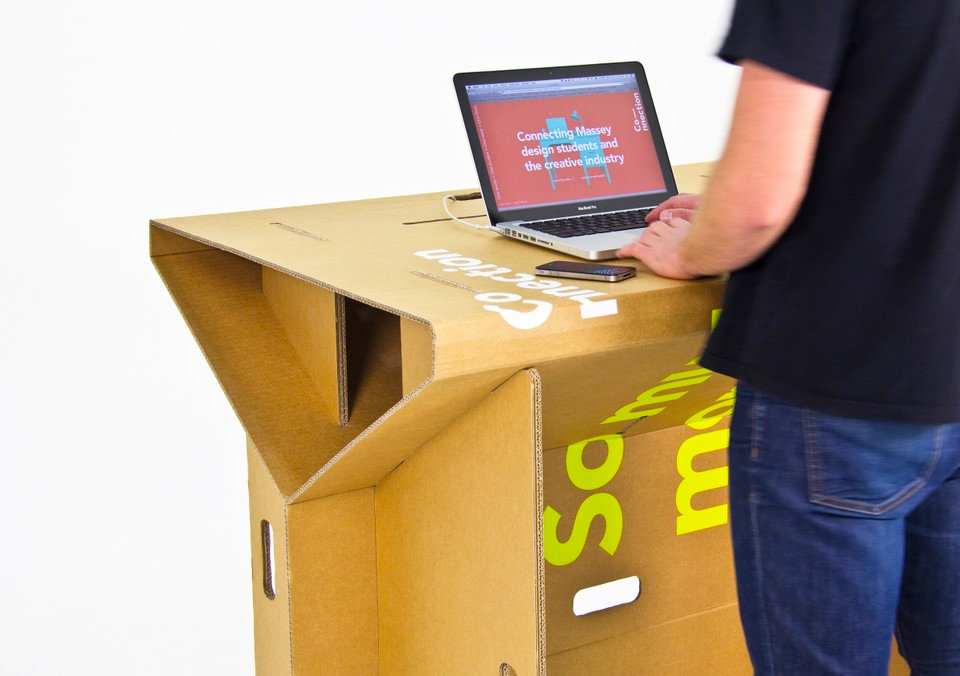
Grant is Professor of Public Health at AUT University and Director of the Human Potential Centre (HPC)–his focus is on how we can live longer, disease-free lives by improving our diet, lifestyle and movement, rather than taking medication.
“The idea of an ergonomic chair where you can stay stationary for a long time is fundamentally stupid,” he says. “I’m not anti sitting, but it’s only recently in human history that sitting has become a normal all-day activity.”
Clearly, this sedentary behaviour is not helping in the fight against obesity, so Grant wants to transform the traditional office environment to encourage more movement.
Research by AUT’s HPC at several New Zealand workplaces shows we can burn 60 more calories a day simply by standing, rather than sitting, at our desks.
The staff at the Centre have been using standing desks for several years. With its location moved to the AUT Millennium Campus (on Auckland’s North Shore) last year, Grant collaborated with the AUT School of Design to create customised furniture for the new offices.


Supervised by Steve Reay, Deputy Head of Product Design, AUT students Daniel Ravlich and Nancy Wang designed height-adjustable office furniture for HPC staff. The ‘un-ergonomic’ stool lets you sit for short periods before standing becomes a more comfortable option. All the units are fully mobile to allow for a flexible office space.
“Our office gets quite a bit of attention and I think it’s an idea that’s growing,” Grant says.
Video: Watch Seven Sharp put it to the test.
Another standing desk that’s gathering attention is Refold by Wellington designers Fraser Callaway and Oliver Ward.
The desk was created as part of their Co-nnection project, a platform to link design students with studios for worthwhile work experience (see the next issue of Idealog–out Monday–for all the details).
“A problem we came across when approaching studios is an apparent lack of desk space,” say Fraser and Oliver. So they created a temporary desk.
The Refold desk is made of recycled cardboard, designed to fold to the size of an A1 art folder. It can be set up in a matter of seconds, anywhere in the studio.
It was created as a standing desk to promote engagement and a healthy work environment, and is available in small, medium and large to cater for most heights.
Refold presently has its own Kickstarter campaign, with more than $29,000 worth of pledged funding.

So, how do standing desks benefit our health?
A recent article by The Huffington Post reports on research by the US National Institute of Health, telling us that “the death rate among those who sit more than six hours a day is about 30% higher than those who sit for about three hours a day.”
According to the Institute’s report, “Evidence supports that reducing time spent sitting, regardless of activity, may improve the metabolic consequences of obesity.”
Of course, as Tech in Asia reminds us, standing all day isn’t healthy for you either. They suggest a happy medium, a balance of standing and sitting throughout the day. Give the following a go to get you started.
Simple exercises during the day
Instead of sitting, try walking meetings, which not only add to your physical activity count, but stimulates alertness and creativity.
Prioritise productivity
If you’re spending too much time fretting about your routine or overexerting, it’s not worth it. If you feel uncomfortable standing after a while, sit. You can always go back to standing later. You’ll get into a rhythm over time.
Start the day by standing, and tie in certain tasks with it. As the day wears on, sit and pair that with other routines. Or, if you prefer, switch between sitting and standing many times a day to keep yourself energised.
Get your sitting and standing posture right
It’s not just how long you stand, but how you stand. This infographic shows the correct posture you should take while at work.





